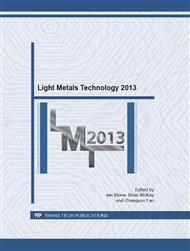p.255
p.260
p.266
p.271
p.276
p.281
p.286
p.291
p.296
Determination of the Magnitude of Interfacial Air-Gap and Heat Transfer during Ingot Casting into Permanent Metal Moulds by Numerical and Experimental Techniques
Abstract:
Numerically and experimentally the size of the casting–mould air-gap was investigated for the aluminium alloy LM25 cast into a cylindrical H13 steel mould. The air-gap significantly affects the magnitude of heat transfer. A numerical model has been developed to predict the size of the air-gap and the temperature distribution along the metal-mould interface given an initial Interfacial Heat Transfer Coefficient (IHTC), dependent on the mould surface roughness, and sufficient knowledge of the radiative and thermomechanical properties of the casting and mould materials. The model is then able to predict the development of the air-gap and the resulting IHTC values over time. Validation was conducted experimentally by measuring the thickness of the air-gap using optical techniques to measure displacements of the mould and the casting surface during solidification. Temperatures of the mould and casting were also measured and allowed the time-varying IHTC to be calculated. A fair agreement between the numerical and experimental results was found, giving confidence in the numerical model’s ability to predict the magnitude of the air-gap and temperature distribution. This can be extended to regions where destructive measurement techniques were not used. The air-gap width for this casting process reached 0.6 mm, for which heat transfer by conduction was found to be dominant over radiative heat transfer.
Info:
Periodical:
Pages:
276-280
Citation:
Online since:
July 2013
Authors:
Price:
Сopyright:
© 2013 Trans Tech Publications Ltd. All Rights Reserved
Share:
Citation:


